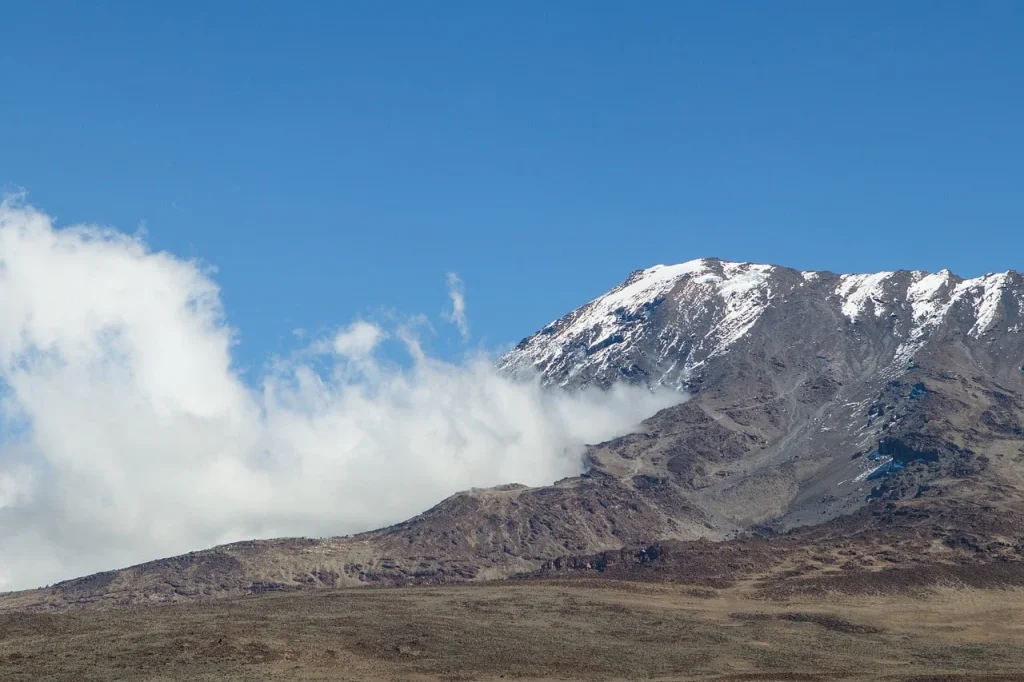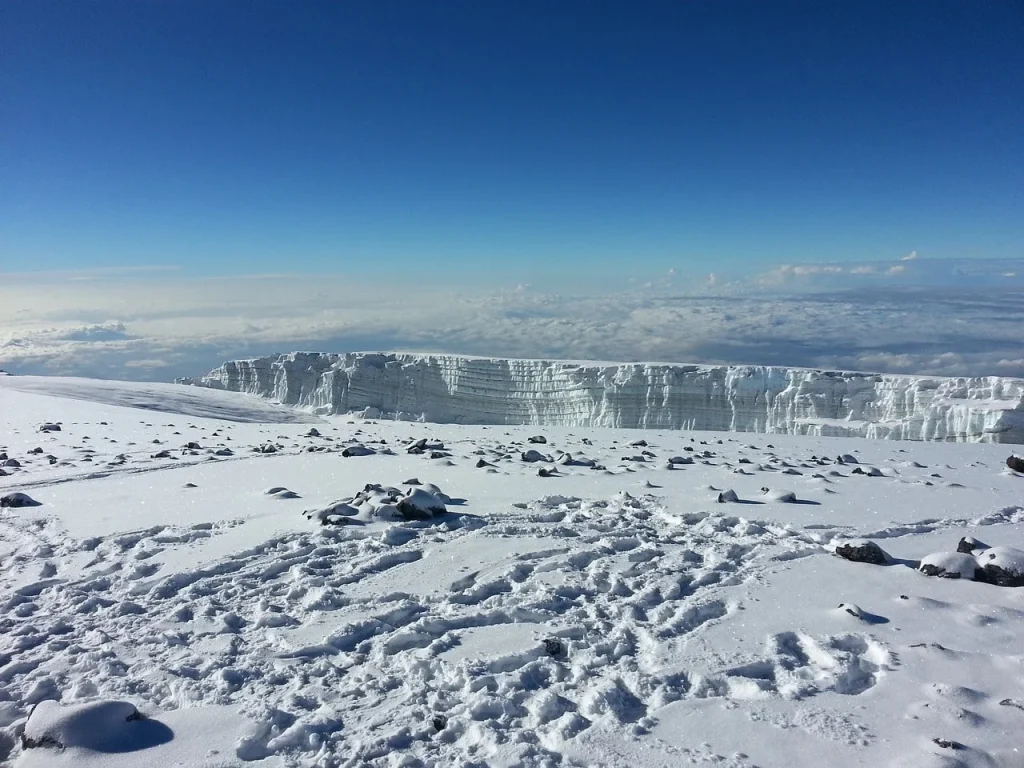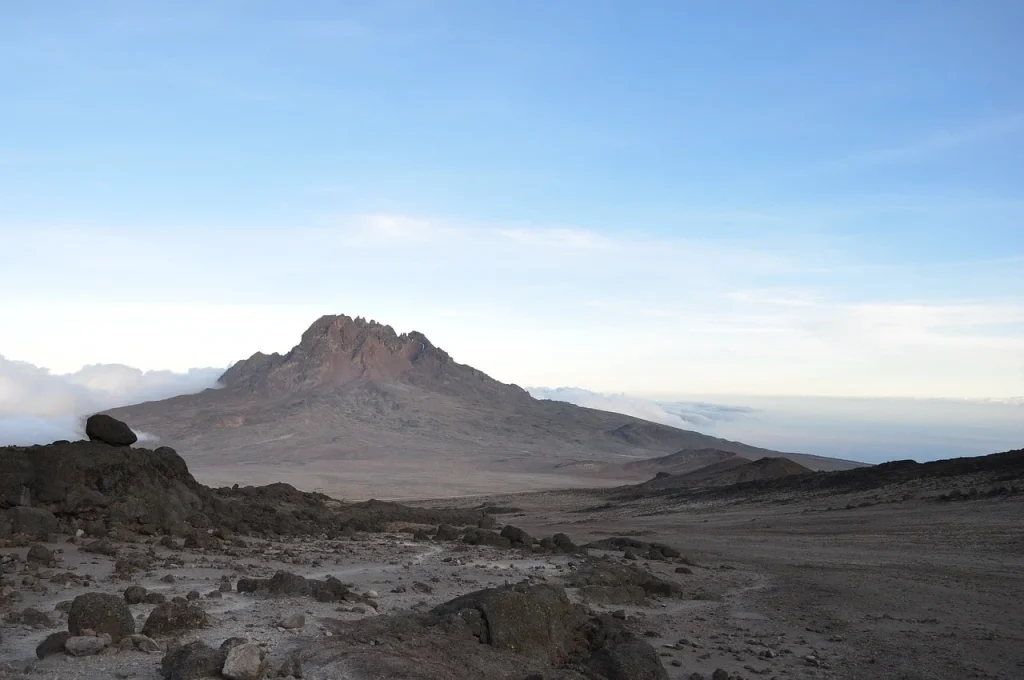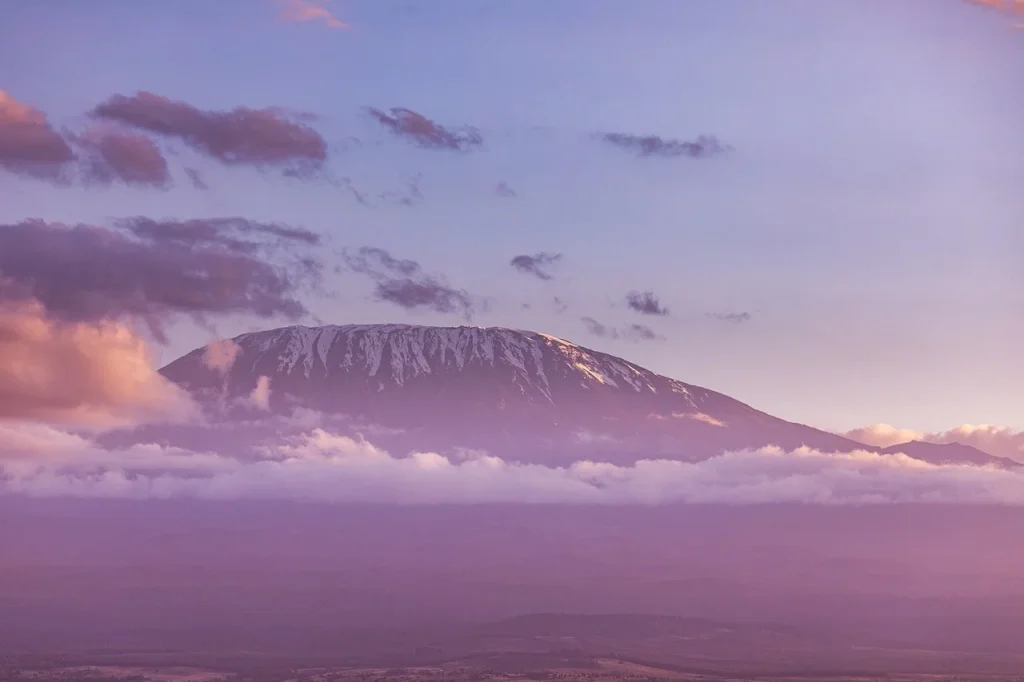Did you know that Mount Kilimanjaro is not just Africa’s tallest mountain but also a symbol of beauty and challenge? This towering giant, located in Tanzania, stands at 19,341 feet and offers more than just a breathtaking view.
It’s a place where diverse climates meet, from lush rainforests to icy glaciers. In this article, we will uncover some amazing facts about Kilimanjaro that highlight its natural wonders and cultural significance.
It is as if all life on our planet is being drawn up to the pinnacled peaks of Kilimanjaro.
Hemingway
Kilimanjaro Facts
Let’s start our journey with the facts. Read them carefully because a quiz awaits you at the end of the page to test your expertise.
- The summit area was once entirely covered by an ice cap, likely more than 100 meters deep, but due to warming trends, the ice has been retreating dramatically.
- Mount Kilimanjaro is the highest single free-standing mountain in the world, rising about 4,900 meters from its base.
- It has three volcanic cones: Kibo, Mawenzi, and Shira, with Kibo being the only dormant cone expected to erupt again.
- The mountain creates its own weather systems and the precipitation at its summit can form glaciers.
- Despite its equatorial location, the summit is cold enough to sustain five major ecological zones from base to peak.
- The fastest verified ascent and immediate descent took about 6 hours and 42 minutes by a Swiss mountain runner.
- Local Chagga people have lived on the lower slopes for over 300 years, utilizing complex irrigation canals for their crops.
- Two different types of lava, trachyte and rhomb porphyry, are found, making its geology uniquely diverse.
- It hosts over 1,000 flowering plants and unique species like the Kilimanjaro tree hyrax and the chameleon.
- Ancient fossilized leaves found near the Lava Tower at 4,630 meters suggest the mountain’s environment changed drastically over thousands of years.
- The mountain was first mentioned by a European when Ptolemy, the Greek philosopher, called it the “great snowy mountain” in the second century.
- It is one of the few places on earth where you can pass through four different climate zones: rainforest, moorland, alpine desert, and an arctic summit.
- The disappearing glaciers and ice caps are considered an indicator of climate change, having decreased by 82% since 1912.

- The first successful summit happened on October 6, 1889, by Hans Meyer and Ludwig Purtscheller.
- This mountain is a popular site for scientific research, particularly on its glaciers and climate change impacts.
- The oldest person to ever summit was an 89-year-old American man, showcasing the range of people who tackle the challenge.
- It supports a wide range of animal life, including leopards, buffalo, and elephants at lower altitudes.
- There are seven official routes for ascent, varying in length, scenery, and difficulty.
- The monthly temperature range on the summit barely changes, averaging -7 degrees Celsius.
- It draws over 35,000 climbers each year, contributing significantly to local and national economies.
- Despite its popularity, the mountain remains one of the deadliest peaks due to altitude sickness, extreme weather, and falls.
- Unlike most mountains, which are climbed primarily for sport, many climb it for charitable causes, raising funds and awareness for various issues.
- One of the routes, the Marangu route, is known as the “Coca-Cola” route, due to its relative ease and the amenities offered along the way.
- Cultural significance abounds, with local communities regarding the mountain as a sacred place, providing water and fertile soil.
- Two ecological phenomena are named after it: the Kilimanjaro effect and the Kilimanjaro syndrome, both describing unique mountain effects on weather and psychological states of climbers, respectively.
- The youngest person to reach the summit was a six-year-old boy, which sparked debates about child safety and ethical tourism.
- An annual event, the Kilimanjaro Marathon, begins at Moshi town at the base and attracts thousands of runners from around the world.
- Its melting glaciers are not only a source of scientific study but also of artistic inspiration, featured in numerous documentaries and films.

- Plant life on the mountain can vary dramatically within a few hundred meters due to rapid changes in altitude and climate.
- Many of the porters who assist climbers are members of local Chagga and Maasai tribes, who have adapted traditions and lifestyles to benefit from tourism.
- The mountain is sometimes called the “Roof of Africa,” and serves as an iconic image of African landscape diversity.
- In the surrounding national park, you can find the largest tusks from elephants, referred to locally as “tusker elephants.”
- Coffee grown on its slopes is highly valued for its rich flavor, attributed to the volcanic soil.
- Water from the glaciers supplies the surrounding communities, but it is rapidly decreasing, raising concerns about future water scarcity.
- Winds can reach up to 200 kilometers per hour on the summit, making climbing conditions perilous at times.
- Climbing records on the mountain are continuously challenged, with adventurers trying new methods to beat previous times.
- Despite its iconic status, many of the routes up the mountain were not professionally mapped until the late 20th century.
- Mountain sickness is an ever-present danger, with the summit’s low oxygen levels affecting up to 75% of climbers.

- The mountain’s massive footprint covers over 1,600 square kilometers, providing a vast area for exploration and conservation.
- Due to global warming, some predict that the ice caps might disappear within the next 20 years, altering the landscape and local ecosystems.
- Cultural artifacts have been found at various altitudes, offering clues to the historical human presence and usage of the mountain.
- The mountain acts as a “sky island,” isolating species on its upper reaches which can be nowhere else on Earth.
- Over 20,000 tons of ice were removed from the glaciers in the 20th century, taken for scientific study and as a water source.
- A green phenomenon known as “moonbow”, a lunar rainbow, has been witnessed by night-time climbers.
- The full moon nights are popular times for summit attempts, as the moonlight illuminates the glaciered landscape.
- Each year, unknown numbers of undocumented local climbers attempt to ascend the mountain, often using hidden trails and without support.
- Multiple climbing deaths each year are attributed not only to the harsh conditions but also to underestimating the mountain’s challenges.
- Remote parts of the mountain are still relatively unexplored, offering potential for new routes and discoveries.
- It’s not only a physical challenge but also a mental one, with climbers needing to prepare for isolation, vast landscape changes, and the rigors of altitude.
- The glacial melt waters from the mountain form the headwaters of the Pangani River, which supports agriculture and wildlife both on the mountain and in the surrounding areas.
Kilimanjaro Myths

Now that we’ve climbed through the facts, we’re ready to continue into the myths. Let’s separate what’s real from what’s merely a mountain legend.
- Kilimanjaro is Extremely Difficult to Climb
While challenging, it is considered one of the more accessible of the world’s highest peaks. It is often trekked by individuals with no previous mountaineering experience, thanks to routes that do not require technical skills. - You Need Special Equipment to Climb Kilimanjaro
Specialized mountaineering gear is not required. Sturdy hiking boots, warm clothing, and basic camping gear are sufficient, as the climb is mainly a trek rather than a technical climb. - Kilimanjaro is Always Snow-Capped
The famous snow cap of Kilimanjaro is diminishing. Due to global warming, much of the ice and snow at the summit has melted over the years, and it is predicted that it might disappear entirely within a few decades. - Climbing Kilimanjaro Does Not Require Preparation
Despite its reputation for accessibility, preparation should not be underestimated. Physical fitness is crucial, and acclimatization to high altitudes is recommended to reduce the risks associated with altitude sickness. - Kilimanjaro is Isolated and Remote
Although situated in a relatively remote area, the region around Kilimanjaro is well-developed for tourism. There are numerous hotels, guides, and tour operators that cater to climbers and tourists, providing accessible services and amenities.
Kilimanjaro Quotes

We are moving on to the next section. Here you will find some of my favorite quotes. You can always share more in the comments and I will add them to the list as well.
Kilimanjaro is a snow-covered mountain 19,710 feet high, and is said to be the highest mountain in Africa. Its western summit is called the Masai ‘Ngàje Ngài’, the House of God.
John Reader
This quote by John Reader, a notable British writer and photographer, emphasizes the awe-inspiring height of Kilimanjaro and its cultural significance to the Masai people.
I’ve seen Kilimanjaro’s mighty snow head wreathed with rising cloud violet and gold, the silver ribbons of the rivers running down her sides.
Isak Dinesen
Isak Dinesen (Karen Blixen), a Danish author best known for her tales of life in Africa, captures the ethereal beauty of Kilimanjaro in this poetic description.
Kilimanjaro belongs to that of the moon. Seen from the plateau, the mountain is all the more grand and inspiring.
David Livingstone
This observation by David Livingstone, the famous Scottish explorer of Africa, compares Kilimanjaro’s mystical presence to that of the moon, highlighting its isolation and grandeur.
The summit of Kilimanjaro is one of the most sublime in Africa. I can see why it has been a guide and inspiration for so many.
Rick Ridgeway
Outdoor adventurer Rick Ridgeway comments on the inspirational and guiding presence of Kilimanjaro’s summit, a point that has motivated countless climbers and explorers.
When you see Kilimanjaro, you understand the meaning of vastness and permanence.
Gloria Reuben
Actress and environmental advocate Gloria Reuben reflects on the profound impact of Kilimanjaro’s immensity and enduring nature, which resonates with those who witness it.
Kilimanjaro FAQ

Next up are the FAQs about Kilimanjaro, the last section before your quiz. Each question and answer could be a vital part of the quiz, so please read them thoroughly.
- Can you see Kilimanjaro from the Serengeti?
Yes, you can see it from parts of the Serengeti on clear days. The view is dependent on weather conditions, as clouds can often obscure the mountain. - Are there dead bodies on Kilimanjaro?
Yes, there have been cases where climbers have died on Kilimanjaro and their bodies were not recovered due to various reasons such as extreme weather or difficult terrain. However, such instances are rare, and most fatalities are safely transported down. - Can you climb Kilimanjaro in a day?
No, climbing it in a day is not feasible for most people. The trek usually takes about 5 to 9 days, depending on the route and pace, to allow for proper acclimatization to high altitudes. - What is the best time to climb Kilimanjaro?
The best time to climb it is during the dry seasons, from late June to October and from late December to early March. These periods generally offer clearer skies and lower precipitation. - How cold does it get on Kilimanjaro?
Temperatures can drop below freezing, especially at higher altitudes. At the summit, nighttime temperatures can fall to -20°C (-4°F) or lower.
Kilimanjaro Trivia

Welcome to the Kilimanjaro Quiz! If you can’t reach the peak of these questions, beware, you might find your next coffee magically turning into mountain dew!
Conclusion
Kilimanjaro, a mountain of myths, stories, and stunning views, has intrigued us all. From its ecological significance to its cultural impact, Kilimanjaro stands tall, not just in height but in its contributions to biodiversity and tourism.
Remember, every step taken on its slopes is a step into a richer understanding of our planet. Till next time, stay curious and explore more. Cheers.
3 Sources Used For This ArticleThe Snows of Kilimanjaro – Xpress English
Is Climbing Kilimanjaro Only for Experienced – Eco Africa Climbing


